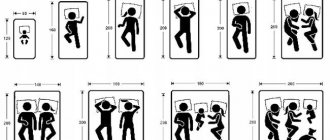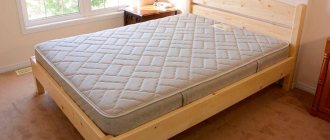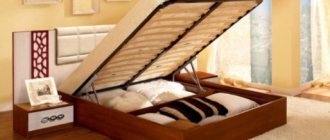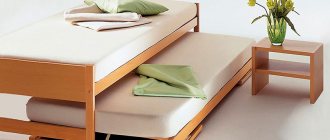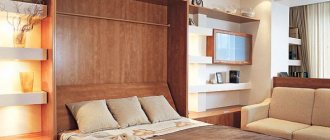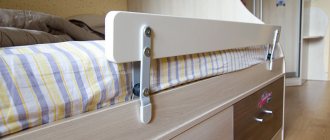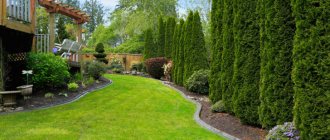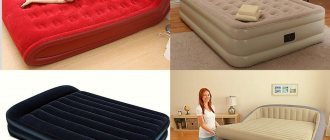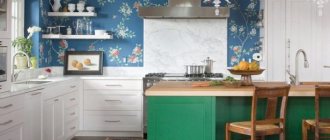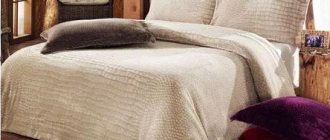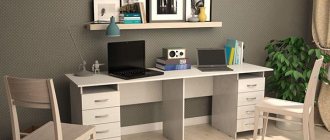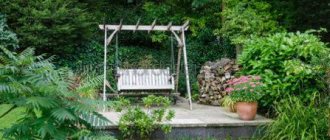When a baby appears in the family, one of the main tasks for young parents is to ensure its safety, including during sleep. To minimize the likelihood of injury at this time, a special protective side for the bed against falls is provided, which can be of completely different configurations. To choose the most functional design, it is worth studying the wide range of models offered by modern manufacturers. If you wish and have basic sewing skills, you can even make such a limiter with your own hands.
Features of using the design
The limiter protects babies from birth to 3–5 years of age from falls, regardless of whether they sleep with their parents or in separate cribs. Older children, and even adults, will also benefit from a side rail, preventing them from falling from the top floor of a bunk bed. Increased safety requirements are imposed on such a sleeping place.
In some cases, a barrier can also be installed on a bed for the disabled to provide safety for people with limited mobility. Such structures must be characterized by increased strength of the material and fastenings in order to withstand the weight of an adult’s body.
In addition to its main function, a bed restrainer can perform additional tasks:
- Protecting the child from drafts. If the bed is placed in a ventilated place or in the direction of the flow of air cooled by the air conditioner, the barrier will prevent the baby from becoming hypothermic. For this purpose, you should choose a model with dense walls.
- Insulation of cold walls adjacent to furniture. In order not to hang wall hangings that have long gone out of fashion, you can insulate the wall with a soft fabric stopper. It would be good if there was foam inside.
- Stylish interior solution. A bed rail, harmoniously combined with the decoration of a children's room, can become the highlight of the room.
When choosing safety barriers for beds, you should pay attention to a number of characteristics: the height of the product, the quality of fastenings, decor and color scheme, thickness and type of insulation. It is also necessary to take into account the child's age, bed size and room design. Particular attention should be paid to the quality of the materials used to manufacture the limiter. Products for children must undergo certification confirming that the product is safe for health, and its characteristics are verified by special tests.
Description
Some modern bed options are initially made with sides, and some have a base for fastenings, under which you can choose the desired option. Temporary bumpers are an excellent solution for a growing child. Such restraints can also be used by adults.
The length of the sides depends on the age of the sleeping person
You can purchase limiters in specialized stores, where a huge range of them is presented. They differ from each other:
- Size.
- Height.
- Color.
- Form.
- Material.
The sides can also be original. They are made by designers depending on the wishes of the customer, as well as taking into account the characteristics of the future user.
Types of limiters
Based on the fact that a bed rail can be used in a variety of cases, for different categories of users, and can also be installed on different types of beds, there are a huge number of product varieties. To correctly choose a functional and reliable protective board, you should understand the features of each type.
Bed guards against falls can be classified according to several characteristics: products differ from each other in the type of material, method of fastening and design.
By material type
Bed restraints are made from a variety of materials. He can be:
- soft;
- mesh;
- plastic;
- wooden.
Models and designs of children's beds with soft backs, popular brands
For the youngest children sleeping in a separate place, soft sides are ideal. Such restraints for a child's bed are made of foam rubber, thick enough so that the baby does not hit the hard bars of the partitions while sleeping. As a rule, such products are equipped with one or more fabric capes. The removable cover can be changed and washed when dirty.
The mesh side is suitable for older children or those babies who sleep with their parents. Protective barriers for children's beds made of mesh are a plastic or metal frame with fastenings, on which an elastic fabric or plastic mesh is stretched. The undoubted advantage of such a board is its breathability. In addition, such a barrier for the bed does not prevent the child from seeing everything that is happening around him in the room. The mounting method on such devices is, as a rule, universal and allows you to hang the fence on any type of furniture.
When constructing a mesh protective barrier for a bed, special attention should be paid to the strength of the material and the reliability of fastening the device to the frame so that the child cannot push through the barrier with the weight of his body.
A plastic side often comes with a bed. This is a ready-made design with a removable or non-removable fastening. The advantage of the product is reliability and high protective properties. The thickness of the plastic used to make the barriers will not allow even an older child to break through it in his sleep and fall to the floor. In addition, this is a fairly soft material, so additional covering of the structure with fabric and a softening layer is not required.
A factory-assembled functional children's bed is most often equipped with wooden sides. The second tier is subject to increased safety requirements, so even if a teenager sleeps there, the furniture is still equipped with protective guards, because a fall from a height higher than a child’s height carries the risk of serious injury.
Soft
Reticulate
Plastic
Wood
By mounting method
Protective restraints for beds may also differ in the type of fastening. The designs are:
- with mechanical fastening;
- with fastening under the mattress;
- removable;
- folding;
- stationary;
- with fabric fastening.
Ready-made plastic or mesh barriers are equipped with a thoughtful and reliable fastening system. Most often, devices are mechanically attached to the frame or bottom of the bed using the bolts included in the kit. They may have a folding design, which in the future will allow an older child to climb into bed independently. This functional bed barrier is a reliable choice for safety.
Sometimes the fasteners are screwed only to the side itself, and the other side is simply placed under the mattress and held on by its mass and the weight of the child lying on it. This barrier is easy to install and can be easily removed, but keep in mind that it is not suitable for a baby under 1 year old, since its weight is still too small to hold the side in place.
Stationary fastenings are most often sold complete with furniture; they can especially often be found as part of bunk beds and couches for teenagers. They are securely connected to the berth and are part of its design. Typically, such sides are made of wood or chipboard.
Characteristic features of a classic children's bed, decor options
The soft barrier has one of the varieties of fabric fastenings. These can be ribbons, ties, Velcro or zippers. Despite the apparent weakness, this fixation is quite reliable. It is only important to pay attention to the quality of the seams and threads.
With mechanical sealing
With fastening under the mattress
Removable
Folding
Stationary
With fabric fastening
Making a single wooden crib for children from 3 years old
The frame of the structure for a child includes a base and backrests, which is clearly shown in the drawing of the bed. The width and length of the product are determined by the dimensions of the mattress. The bottom of the bed should be no more than 35 cm from the floor, which will allow the child to climb onto it without effort.
The frame is made of two crossbars, which are made from edged boards measuring 50x100 mm. The required length of the product is measured with a tape measure, which is indicated with a pencil. According to the mark, two boards of a given size are sawn off using a jigsaw. Glue is applied to the side of each crossbar. Using self-tapping screws, 25x50 mm strips are fixed in these places for attaching the lamellas, and they should be 10 cm shorter than the crossbar.
Single children's bed with sleeping place 850x1935 mm
How is the base prepared for the mattress of a children's bed from 2 years old? To do this, boards are cut from slats (20x20 mm), the length of which corresponds to the width of the mattress. Their number is determined based on the complete filling of the base space. Products with a stop are attached parallel to each other to the crossbar strips using self-tapping screws. The step between them should be no more than 10 cm.
Then you need to sand all the holes for the fasteners. In the outer slats there are cutouts for the legs of the bed, which are made from timber measuring 50x50 mm in the amount of 8 pieces. The four elements under the headboard should be longer than those under the footboard. The blanks are glued together in pairs and fixed with self-tapping screws.
Creating bed side elements for children from 3 years old
The next step is to use an electric drill to make holes for dowels in boards with a 25 mm wide groove, which are used to make the footboard and headboard of the structure. They are drilled into the ends of the planks. You should be extremely careful when making holes, which should be located at the same level on all planks. They need to have the same depth, which is equal to ½ the length of the board.
The headboard and footboard of the bed can be made from solid pieces of chipboard or MDF. The first element is longer than the second. The width of the parts is determined based on the value of this parameter of the mattress, to which is added the double thickness of the wall of the longitudinal bars of the bed frame. Products can have a different shape of the end part, which can be round or wavy. If the side elements of the bed are made with railings, then another 25 mm should be added to the width of the product.
Holes for edgings in the bed parts are made using a drill
If wooden boards are used to make the side elements of a bed for children over 2 years old, then the following sequence of actions is required. Parts of equal length are cut from bars measuring 25x50 mm. They are inserted into the grooves of vertical boards filled with glue. The legs have holes for dowels. They house the side structural elements. The parts should be pressed tightly, excluding distortions and cracks.
Having made the vertical supports of the side elements, they should be tied with a frame around the perimeter to create a wooden roof. The last step is to attach the ridge beam, which will connect the base of the bed-house structure with your own hands. After all the parts of the product have been prepared, it is time to assemble them. Each element is first checked for chips and gouges, which are sealed with a putty mixture, and the surface is sanded to a smooth state. Next, all parts are treated with a primer or stain. After they have completely dried, the surface of the products is coated with paint.
Choosing the appropriate height and side size
The height and size of the sides should be selected based on the child’s age and degree of mobility in order to ensure the baby’s safety not only in sleep, but also during active games in the bed.
| Child's age | Types of activity | Side height, cm | Item size |
| 0–6 months | The child lies in the crib, turns over, sits up, tries to crawl | 30–40 | Full length of the bed |
| 6 months - 1 year | The child gets up in bed, holding onto the railings, actively crawls, tries to climb over the sides | 70–90 | Full length of the bed |
| 1–3 years | The child stands confidently on his feet, walks, gets in and out of bed independently | 20–30 | Full length of the bed |
| 3–6 years | The child gets up and lies down independently; the bed can be in a room separate from the parents’ bedroom | 20–30 | Partially covers the long edge of the bed |
| Second tier of bed regardless of age | — | Approximately 20 cm | Full length of the bed |
The height of protective barriers should also be chosen based on the child’s motor activity. The maximum value should occur at a time when the baby is still unsteady on his feet, but already wants to actively explore the world - he stands up in the crib, holding on to the sides, and tries to get out of it, crossing his legs. It is between the ages of 6 months and a year that the risk of injury from falling out of bed increases several times compared to any other age. A high side is necessary so that the child does not fall when trying to climb over it.
Protective bumper
In the photo: protective bumper, Ozon, RUB 5,190.
An ideal option that solves the problem not only for infants, but also for children over 2 years old. The bumper cannot be pushed onto the floor; the sides are securely attached to the bed or sofa, turning them into a full-fledged playpen.
Pros: the side is fixed easily, but at the same time securely. It's also easy to remove if needed. It can even withstand a teenager rolling over to the edge of the bed, so they can be used not only for co-sleeping, but also for teenagers sleeping restlessly in their beds.
Cons: the price of this accessory may seem too high to some, although even in this selection there are less convenient, but comparable in price options.
Colors and decor
Among the variety of decorative options for bed restraints for children, everyone can easily find the perfect one for themselves. There are several nuances that will help make the choice easier. Modern psychologists unanimously claim that the younger the child, the more important it is for him to have different colors, patterns and details in his sleeping area. Looking at them every day, the baby develops vision, perception of color, size and perspective. Therefore, it would be a mistake to purchase monochromatic designs - it would be better if they had a small print of delicate pastel colors.
Traditionally, pink interior items are chosen for girls and blue for boys. This is an optional rule. Combinations of simple colors in soft shades look good - blue and yellow, green and pink.
An older child’s room or corner can be decorated in simpler shades, repeating the color scheme of the nursery’s interior. It’s good if it reflects the baby’s character or his hobbies. For a comic book lover, you can choose models with superheroes depicted on them, and for a young car collector, you can choose a racing track.
Types of beds for newborns, product requirements
When choosing a design option, it is important to pay attention to the properties of colors. So, yellow lifts the mood, green calms, and orange excites the psyche. In any case, it is recommended to refrain from an abundance of such active colors as black or red, or introduce them very carefully, with small color accents.
The best manufacturers
The market for barriers for children's beds is represented by many manufacturers. User experience allows us to highlight several trusted brands:
- Lindam is a well-known brand from the USA that produces folding mesh bed barriers. It is distinguished by high quality and a well-thought-out fastening system.
- Ikea is a famous Swedish brand that traditionally produces a wide range of products for children, including removable soft sides in cribs for newborns.
- Baby Safe is a Chinese brand widely represented on the Russian market. Mainly produces mesh barriers.
- Leader Kids is a domestic manufacturer of textiles for children. It is distinguished by a variety of prints and colors, and the high quality of the raw materials used.
- Sweet Baby is a joint Russian-Italian production. The assortment includes a variety of models of fabric bumpers and pillows in trendy colors. High-quality natural fabrics are used in production.
To ensure that the model perfectly matches your personal preferences and needs, you can make the protective rim yourself.
Lindam
Ikea
Baby Safe
Leader Kids
Sweet Baby
How to make it yourself
Despite the variety of finished products, it will be easy for handmade lovers to make a bed restrainer with their own hands. Made by hand, it will reflect the individual taste of the creator, and in terms of functionality it will not be inferior to factory models.
For those who are comfortable with a sewing machine and an overlocker, it will not be difficult to understand how to make a soft barrier for a bed. During the work you will need:
- foam;
- fabric for making covers;
- zipper;
- threads, pins, needles, scissors.
When all the necessary materials are prepared, you can begin manufacturing. The design of the soft sides is so simple that it does not require a pattern.
- First you need to cut the foam rubber to the internal size of the sides of the bed. You should get 4 parts - 2 narrow (for the ends) and 2 long.
- Next, blanks for covers and ties should be cut from chintz or calico. For covers, the fabric should be wrapped around the foam element, mark 2 cm on each side for the seams and cut off.
- Sew a “bag” from the resulting cuts, stitching the seams on a machine.
- Sew a zipper into the remaining unstitched short side of the pillow.
- At the end, turn out the resulting covers, put them on foam blanks, and attach the finished structure to the crib.
Experienced craftswomen can add frills made of contrasting fabric to the pillows; they are sewn into the seams of the covers.
Bed bumpers are a very useful device that provides maximum safety and comfort to a sleeping child. In addition, they are a stylish addition to the interior of a nursery, which is why the product is very popular among parents of babies.
